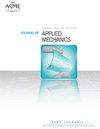On Jump Discontinuities in Internal Forces of Flexible Structures Carrying Moving Subsystems
IF 2.8
4区 工程技术
Q2 MECHANICS
引用次数: 0
Abstract
Abstract Combined systems, which are flexible structures carrying moving subsystems, are seen in various applications. Due to structure–subsystem interactions, the structure in a combined system encounters jump discontinuities in its internal forces (such as the bending moment and shear force of a beam). Accurate estimation of such jump discontinuities is important to the performance, safety, and longevity of a combined system. Because of the time-varying nature and complexity of structure–subsystem interactions, conventional series solution methods experience slow convergence, and the Gibbs phenomenon in computation and the improved series expansion methods are limited to certain proportionally damped continua under moving forces and moving oscillators. In this paper, a novel modified series expansion method (MSEM) is proposed to resolve the aforementioned issues with the existing series solution methods. Through the introduction of a jump influence function, the proposed method produces fast-convergent series solutions and accurately predicts the jump discontinuities without the Gibbs phenomenon. The MSEM is applicable to structures with nonproportional damping and subject to arbitrary boundary conditions, and it can easily manage general M-DOF moving subsystems having multiple contact points with a supporting structure. As an important result of this investigation, a mathematical proof of the convergence of the MSEM-based solutions is given for the first time. Additionally, two numerical examples are presented to demonstrate the accuracy, efficiency, and versatility of the proposed MSEM in modeling and analysis of combined systems.承载运动子系统的柔性结构内力的跳跃不连续
组合系统是一种承载运动子系统的柔性结构,有着广泛的应用。由于结构-子系统的相互作用,组合系统中的结构在其内力(如梁的弯矩和剪力)中遇到跳跃不连续。准确估计这种跳变不连续对组合系统的性能、安全性和使用寿命至关重要。由于结构-子系统相互作用的时变性质和复杂性,传统的级数解方法收敛速度慢,计算中的吉布斯现象和改进的级数展开方法仅限于运动力和运动振子作用下的一定比例阻尼连续体。本文提出了一种改进的级数展开法(MSEM)来解决现有级数求解方法存在的上述问题。通过引入跳变影响函数,该方法能产生快速收敛的级数解,并能准确预测跳变不连续而不出现吉布斯现象。该方法适用于具有非比例阻尼和任意边界条件的结构,能够方便地管理具有多个接触点和支撑结构的一般多自由度运动子系统。作为本研究的一个重要成果,本文首次给出了基于msem的解的收敛性的数学证明。此外,给出了两个数值算例,以证明所提出的MSEM在组合系统建模和分析中的准确性、效率和通用性。
本文章由计算机程序翻译,如有差异,请以英文原文为准。
求助全文
约1分钟内获得全文
求助全文
来源期刊
CiteScore
4.80
自引率
3.80%
发文量
95
审稿时长
5.8 months
期刊介绍:
All areas of theoretical and applied mechanics including, but not limited to: Aerodynamics; Aeroelasticity; Biomechanics; Boundary layers; Composite materials; Computational mechanics; Constitutive modeling of materials; Dynamics; Elasticity; Experimental mechanics; Flow and fracture; Heat transport in fluid flows; Hydraulics; Impact; Internal flow; Mechanical properties of materials; Mechanics of shocks; Micromechanics; Nanomechanics; Plasticity; Stress analysis; Structures; Thermodynamics of materials and in flowing fluids; Thermo-mechanics; Turbulence; Vibration; Wave propagation

 求助内容:
求助内容: 应助结果提醒方式:
应助结果提醒方式:


